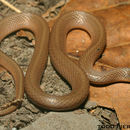en
names in breadcrumbs


The smooth earth snake (Virginia valeriae) is a species of nonvenomous natricine colubrid snake native to the eastern half of the United States.
The specific name or epithet, valeriae, is in honor of Valeria Biddle Blaney (1828–1900), who collected the first specimen in Kent County, Maryland, and was a first cousin of Spencer Fullerton Baird.[4][5]
The smooth earth snake is found from Texas and Iowa to New Jersey and Florida.
The following is a description of the scalation of V. valeriae. Rostral nearly as deep as broad, visible from above; internasals much shorter than the prefrontals; frontal longer than broad, shorter than the parietals; loreal one and a half to two and a half times as long as deep; two or three postoculars; temporals 1+2; six upper labials, third and fourth entering the eye; four lower labials in contact with the anterior chin shields, which are as long as or shorter than the posterior. Dorsal scales in 15 or 17 rows. Anal divided. Ventrals 111-135; subcaudals 24-37.[6]
The following description of coloration of a live specimen (not in alcohol) uses Robert Ridgway's Color Standards and Color Nomenclature (1912). Dorsally Virginia valeriae is benzo brown, deep brownish drab, mars brown, or light brownish drab. The first row of dorsal scales is colored like the adjacent ventrals, which are light vinaceous-fawn, pale vinaceous-fawn, pale grayish vinaceous, or pale vinaceous-pink. The top of the head is hair brown or like the dorsum, with many dark spots on the plates. The upper labials are ecru-drab or lighter, some with drab-gray spots. There is a small black ring around the eye. The ventral surface of the head is white.[7]
Sometimes a faint median light line is present. Also, there may be tiny black spots on the back and sides, especially in the nominate race (Virginia valeriae valeriae).[8]
Adults are usually 18–25 cm (7.1–9.8 in) in total length (including tail); record 33.7 cm (13+1⁄4 in).[3]
The smooth earth snake is a small, fossorial species which spends most of its time buried in loose soil or leaf litter.
The smooth earth snake eats primarily earthworms and soft-bodied arthropods.[9]
Given its lack of sufficient defense mechanisms against larger animals, the smooth earth snake is generally not aggressive towards humans and is harmless if encountered. While it does have teeth, the size of the mouth and teeth make any strikes against humans superficial at worst. It may defecate as a defense mechanism to make itself less palatable to would-be predators. If necessary, it can be safely picked up by hand and relocated.
Including the nominotypical subspecies, three subspecies of Virginia valeriae are recognized as being valid. These subspecies have been considered full species.[2]
Nota bene: A trinomial authority in parentheses indicates that the subspecies was originally described in a genus other than Virginia.
V. valeriae bears live young in August. Brood size is usually fewer than 10. The total length of a newborn is about 6 cm (about 2.5 in).[7]
The smooth earth snake (Virginia valeriae) is a species of nonvenomous natricine colubrid snake native to the eastern half of the United States.